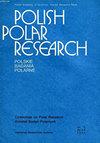Mosses and liverworts in the glacier forelands and mature tundra of Svalbard (High Arctic): diversity, ecology, and community composition
IF 0.8
4区 地球科学
Q4 ECOLOGY
引用次数: 4
Abstract
: The harsh polar environment results in the dominance of mosses and liverworts in tundra communities. To date, very little research has been devoted to the diversity and ecology of these groups in the High Arctic. The aim of this research was to investigate the diversity and community composition of mosses and liverworts in various stages of the ecogenesis of Svalbard ecosystems, and to identify environmental factors affecting species distribution. In 2017, 270 plots were established in a grid in eight glacier forelands and the mature tundra surrounding them. Within these plots, the percentage cover of mosses and liverworts was investigated. In 201 plots, soil samples were taken and environmental data (aspect, bare ground cover, biological soil crust cover, distance from the glacier forehead, rock cover, slope, time elapsed since the glacier’s retreat,斯瓦尔巴冰川前陆和成熟冻土带的苔藓和苔类:多样性、生态学和群落组成
本文章由计算机程序翻译,如有差异,请以英文原文为准。
求助全文
约1分钟内获得全文
求助全文
来源期刊

Polish Polar Research
ECOLOGY-GEOSCIENCES, MULTIDISCIPLINARY
CiteScore
2.00
自引率
7.70%
发文量
0
审稿时长
>12 weeks
期刊介绍:
The quarterly Polish Polar Research edited by the Committee on Polar Research of the Polish Academy of Sciences is an international journal publishing original research articles presenting the results of studies carried out in polar regions.
All papers are peer-reviewed and published in English.
The Editorial Advisory Board includes renowned scientist from Poland and from abroad.
 求助内容:
求助内容: 应助结果提醒方式:
应助结果提醒方式:


